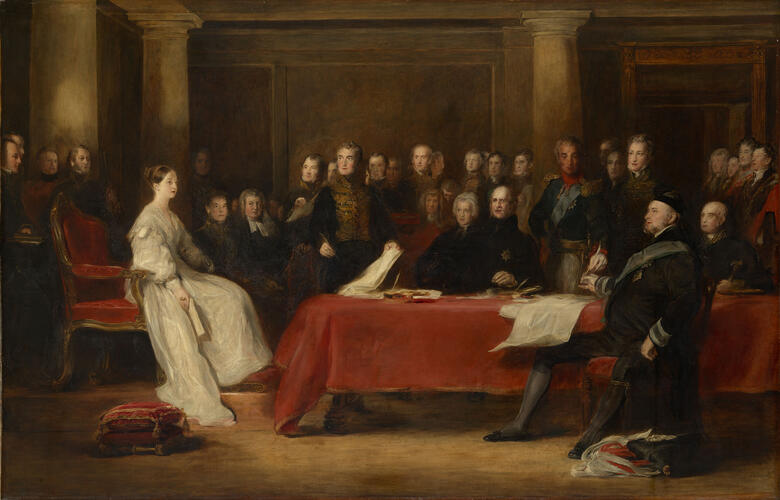-
1 of 253523 objects
The First Council of Queen Victoria Signed and dated 1838
Oil on canvas | 152.7 x 239.0 cm (support, canvas/panel/stretcher external) | RCIN 404710
-
David Wilkie was one of the most successful painters of the Regency period and was greatly encouraged by the Regent. Born in Fife, trained in Edinburgh, Wilkie settled in London in 1805 and began regularly exhibiting at the Royal Academy small scale scenes of everyday life. At this time Dutch and Flemish old master paintings were hugely popular and expensive, as is demonstrated by the works collected at this time by George IV. Wilkie began his career consciously emulated the low-life scenes of Teniers and Ostade, but by the 1820s he had begun to set his sight rather higher, taking Rubens has his model, in particular the fluid and painterly character of Rubens’s oil sketches. Wilkie’s royal career involved succeeding Raeburn as Limner to the King in Scotland in 1823 and Lawrence as Principal Painter in Ordinary to the King in 1830; he remained in these positions until his death, although Queen Victoria disliked this work and had as little as possible to do with the artist subsequently.
Queen Victoria held her first council in the Red Saloon at Kensington Palace at eleven on 20 June 1837; William IV had died in the early hours of that morning, so this was not in Princess Victoria's diary when she retired on the previous evening. She was eighteen years old at the time but behaved, according to Greville's account, with 'perfect calmness and self-possession'. The members of the Accession Council are identified in the key published with Charles Fox's engraving after the picture. The most prominent are: Charles Greville (1794-1865) the author of the famous account of the episode at the extreme left; Lord Melbourne, holding the paper centrally; Ernest Duke of Cumberland and (for the last few hours) King of Hanover, seated just to the left of the right-hand column; The Duke of Wellington, standing in front of this same column; Augustus, Duke of Sussex, seated on the near side of the table.
It is clear that Wilkie intends this painting to be a modern re-telling of a familiar subject in art: the ‘Finding in the Temple’, when the boy Christ is discovered by his parents disputing with the Elders. This narrative and visual parallel seems clever and appropriate, especially as the Duke of Sussex always wore a Jewish skull-cap. When this painting was completed in 1838, the Queen described it as ‘one of the worst pictures I have ever seen, both as to painting & likeness’. At a stroke Queen Victoria dismissed the ‘painterly’ depiction of ceremony in favour of the purely documentary, practised by Sir George Hayter (1792-1871) and many others.Provenance
Painted for Queen Victoria; recorded hanging in the Grand Corridor at Windsor Castle in 1860
-
Creator(s)
Acquirer(s)
Subject(s)
-
Medium and techniques
Oil on canvas
Measurements
152.7 x 239.0 cm (support, canvas/panel/stretcher external)
193.3 x 279.5 x 15.0 cm (frame, external)
Category
Object type(s)
Other number(s)
Alternative title(s)
The First Council of Queen Victoria in Kensington Palace, 20 June 1837.
